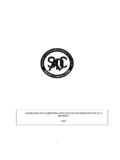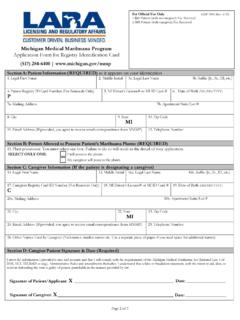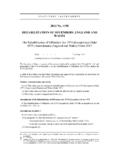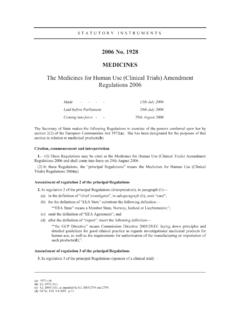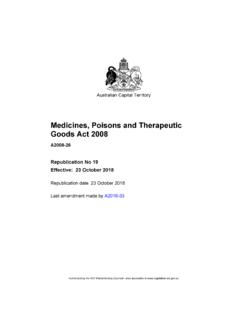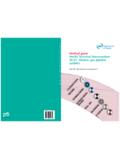Transcription of Cardiac Failure in Children - World Health Organization
1 17th Expert Committee on the Selection and Use of Essential Medicines Geneva, March 2009 Cardiac Failure in Children Sean Beggs1 Angus Thompson2 Rose Nash2 Anna Tompson2 Gregory Peterson2 1. Paediatric Department, Royal Hobart Hospital and University of Tasmania 2. UMORE, School of Pharmacy, University of Tasmania September 2008 Contents Summary_____3 Introduction_____5 Burden of disease from Cardiac Failure in children_____6 What medicines are essential for the treatment of Cardiac Failure in Children ? _____ _____8 Current status of the EMLc and guidelines _____8 Diuretics_____9 Digoxin_____11 Angiotensin converting enzyme inhibitors (ACE inhibitors)_____13 Angiotensin receptor blockers (ARBs)_____16 Aldosterone antagonists_____17 Beta blockers_____18 Antiarryhtmic drugs_____19 Inotropes_____19 Other therapies_____19 Discussion_____19 Treatment_____19 Unanswered Questions_____27 Conclusion_____21 Appendix 1: Search Strategy_____22 References_____35 Page 2 of 31 Summary In Children , Cardiac Failure is most often caused by congenital heart disease and cardiomyopathy.
2 These causes are significantly different from those usually responsible for the condition in adults, which include coronary artery disease and hypertension. Literature searches were undertaken using a variety of search engines including PubMed, the Cochrane Library, BMJ Clinical Evidence and the National Guideline Clearinghouse to identify evidence for the management of Cardiac Failure . There is a large amount of research published on the management of heart Failure in adults, which has given rise to significant changes in management in the last decade. However, there are far fewer studies in Children and those which do exist are often small, retrospective and use a diverse range of measures to assess efficacy.
3 As a result, the management of Cardiac Failure in Children has largely evolved based on clinical experience and the application of adult data, supported by the more limited paediatric literature. Given the significant differences in aetiology of heart Failure between the adult and paediatric populations, this is not ideal. However, clinical experience in paediatrics with the drugs which have been proven to be beneficial in adults provides some re assurance that the outcomes may be similarly beneficial. On this basis, it is recommended that the EMLc is expanded to include additional treatment options for Children with Cardiac Failure , namely an ACE inhibitor and a beta blocker.
4 In the case of ACE inhibitors, the two supported by the greatest paediatric data are captopril and enalapril. The former has the advantage of greater stability in liquid formulation and the latter the advantage of requiring less frequent dosing. It should be noted that there is very limited published data on the paediatric use of those ACE inhibitors most widely used in adults (such as ramipril, lisinopril and perindopril) and none at all in Children with heart Failure . Captopril is proposed for addition to the EMLc, as the representative of the ACE inhibitor group. In terms of beta blockers, the vast majority of evidence in paediatric Cardiac Failure is with carvedilol, which is supported by findings from the trials in adults, where it has been consistently shown to improve outcomes.
5 Carvedilol should therefore be considered the beta blocker of choice in Children with Cardiac Failure and be considered for inclusion on the EMLc. The EMLc already includes a number of drugs used in management of Cardiac Failure in Children : frusemide, digoxin, spironolactone and dopamine. Although this review considers it appropriate to retain these four drugs in the EMLc at the current time, it should be noted that there is a lack of robust research to support the use of these drugs in the paediatric heart Failure population; in particular digoxin, which appears to remain widely used based solely on long standing clinical practice.
6 Although Angiotensin Receptor Blockers (ARBs) are increasingly used in Cardiac Failure in adults, especially where there is intolerance to ACE inhibitors, there is no published evidence supporting their use in Children with the condition. Consequently, it is not considered appropriate to include an ARB in the EMLc at the current time. Whilst there is data emerging for a range of other therapy options, this is not sufficiently robust to warrant their inclusion in the EMLc at the current time. Page 3 of 31 By adding an ACE inhibitor and beta blocker to the EMLc, a greater number of those Children worldwide who have Cardiac Failure should be able to benefit from improved outcomes.
7 There is also a pressing need for improved research into the treatments used in paediatric Cardiac Failure , as well as extension of product licenses where appropriate; and greater availability and standardisation of the formulations required for effective delivery of these treatments. In addition to work around the drugs used to treat heart Failure , continued efforts to reduce the burden of malnutrition and malaria which may exacerbate heart Failure through anaemia and other causes; are essential in developing nations. Introduction The subcommittee of the Expert Committee on the Selection and Use of Essential Medicines identified Cardiac Failure as an area where more information was required to inform their decision for future meetings.
8 The aim of this review was to address the following questions that came out of the initial meeting. 1. What is the burden of disease from Cardiac Failure in Children under 12 years of age? 2. What medicines are essential for treatment? 3. Are these already on the EMLc in an appropriate dosage form and strength? 4. If not, what needs to be added? In order to address the above questions, a search and review of existing literature was undertaken, as outlined in Appendix 1. Burden of disease from Cardiac Failure in Children Cardiac Failure is a clinical syndrome where the heart is unable to provide the output required to meet the metabolic demands of the body; however, the causes and mechanisms of Cardiac Failure are significantly different between adults and Children (1).
9 In adults, Cardiac Failure usually involves Failure of the left ventricle, with the most common causes in developed nations being coronary artery disease; hypertension induced Cardiac stress, arrhythmias and valvular disease. In developing nations, it has been reported that other causes are frequently implicated, including rheumatic heart disease ( ) and cardiomyopathy ( ) (2). In Children , the causes of Cardiac Failure are significantly different and many cases are due to congenital malformations, such as left to right shunts. In these patients the function of both the right and the left ventricles will be affected and these Children suffer from high output Cardiac Failure .
10 Other significant causes of heart Failure in Children are cardiomyopathy (3) and anthracycline toxicity, which lead to low output Cardiac Failure . In developing nations, many cases are caused or exacerbated by anaemia, often secondary to malaria and malnutrition (4). It has also recently been identified that infants in ethnic minority groups in Page 4 of 31 developed countries may be at risk of heart Failure linked with hypocalcaemia and vitamin D deficiency (5). There is also a much higher proportion of Children with heart Failure who have undergone Cardiac procedures ( ) compared to adults with heart Failure ( ); this reflects the incidence of congenital defects, frequent surgical intervention to correct this, and the subsequent and eventual deterioration in Cardiac function that is seen in many of these Children .










